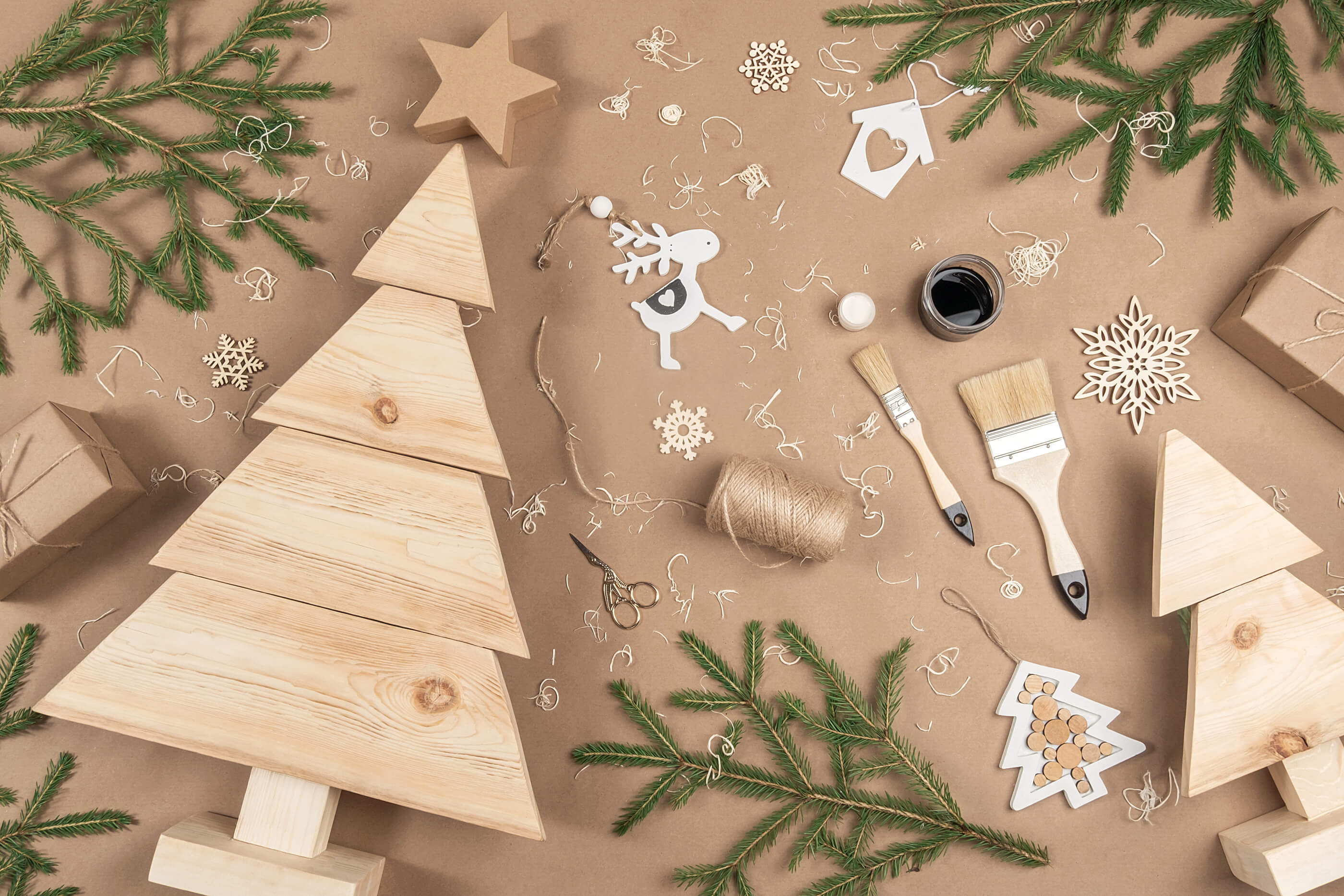Christmas is by far one of the busiest and most celebrated holidays in the UK. It is the time when we eat the most food, spend the most money, and of course, enjoy ourselves in the company of family and friends.
But while we feast, wine, and dine our way through December and into January, what toll does Christmas have on the environment? Keep reading to find out more.
Is Christmas pollution really that bad?
Waste is important and will have an important part to play in our future too, but it doesn’t mean that we shouldn’t enjoy Christmas or feel guilty about wrapping presents for our friends and family.
With that in mind, however, below is a table of the average extra waste generated over the Christmas period each year, based on January rubbish and recycling collections.

What is the impact of Christmas food on the environment?
It could be said that overeating is a tradition in itself, but each year we munch and guzzle our way through 370 million mince pies, 250 million pints of lager and beer, 35 million bottles of wine, and ten million turkeys!
Accumulated, this means that during the Christmas season, we eat as a nation, 80 per cent more food than during the rest of the year.
The downside to this, however, is that we are producing excess waste and pollution to the point where we are binning 230,000 tonnes of food during the Christmas period.
That’s the equivalent of 74 million mince pies or two million turkeys, at the price of £275 million.
In fact, the University of Manchester recently calculated that our combined Christmas dinners produce the same carbon footprint as a single car travelling 6,000 times around the world.
Of course, there are also financial impacts, and each household is expected to spend at least £170 on festive food this year, despite 35 per cent of people admitting that they throw more food away at Christmas than at any other time of the year.
Read about the full impact of Christmas food waste in our Christmas food waste article.
How does wrapping paper affect the environment?
As well as food, it is also important to think about the wrapping paper and packaging that we purchase, use and discard during the Christmas period.
In 2016, we threw away no less than 227,000 miles of wrapping paper, enough to wrap around the Island of Jersey
Additionally, if we placed all our Christmas cards alongside one another, they would stretch around the world 500 times.
We also get through 4,500 tonnes of tin foil and 125,000 tonnes of plastic packaging during the Christmas season.
Greenpeace recently found that as little as one kilogram of wrapping paper emits three and a half kilograms of CO2 during its production process, taking around one and a half kilograms of coal to power its production. This does not take into account further packaging and transportation.
Are Christmas trees bad for the environment?
Many people have short-lived debates over buying fake or real Christmas trees, but this decision has consequences for the environment.
We buy around eight million real Christmas trees each year, with over five million households opting for artificial trees.
Here is a little information about both artificial and real Christmas trees.
Artificial trees
Artificial trees have a carbon footprint equivalent to around 40kg of greenhouse gas emissions, and the main material in artificial trees is plastic; they contribute to the plastic pollution problem worldwide.
As artificial Christmas trees are non-biodegradable, they are sent to landfill or are incinerated, which, again, has a terrible impact on the environment via emissions.
Often, artificial trees are produced in South Korea, Taiwan, or China, and are shipped thousands of miles to get to your home.
Real Christmas trees
Real Christmas trees are grown over a period of seven to ten years and are biodegradable!
Not only do they benefit the environment by having a lower carbon footprint due to shorter travel, but they also help protect and stabilise the soil.
If you’re looking to buy a real tree for a green Christmas, Friends of the Earth advise you to look for one locally produced or grown in the UK with an FSC certification.
Changes you can make to have an eco-friendly Christmas
Being eco-friendly doesn’t mean you have to cancel Christmas. There are plenty of ways you can help the environment while celebrating the holiday.
Although Christmas will be a little different this year due to COVID-19, we’ve put together a list of changes you can make to have an eco-friendly Christmas while reducing waste and your environmental impact.
Switch to rechargeable batteries
Now more than ever, we are showering our friends and family with electronic toys and devices of great variety. The only issue is that some of these gifts require disposable batteries.
On average, we buy ten batteries per year for gadgets and toys. In 2009, only two out of every ten found their way to recycling plants. The EU Batteries Directive has set battery recycling targets at 45 per cent for 2016.
In 2015, the UK recycled 36 per cent of all batteries and 83 per cent of lead-acid batteries. You can now recycle used batteries in shops around the UK, as stores selling more than 32kg of batteries a day must provide in-store recycling bins.
One way to tackle battery waste is by switching to rechargeable batteries. They can be reused up to 1500 times, which helps the environment, and they are also a cheaper option for powering toys and devices.
Buy sustainable Christmas decorations
It is without a doubt that Christmas lights are part and parcel of most living room decorations during December and January.
Unfortunately, however, Christmas tree lights tend to be switched on for an average of ten hours a day, which produces enough CO2 to fill five party balloons, if they happen to be incandescent bulbs.
However, you can still enjoy Christmas tree lights while being eco-friendly. For example, a 70-count string of five millimetre Wide Angle LEDs uses only around five watts, whereas a 100-count string of incandescent mini lights would run at 40 watts.
Old incandescent bulbs can use up to 80 per cent more wattage, and at the same time, use up to 90x more power than LED bulbs.
Another way to be sustainable with Christmas decorations is by creating your own. Although times are hard with COVID-19, you could go on a walk to collect some sticks and create ribbon tree decorations!

Freeze any Christmas dinner leftovers
It’s not unusual to have eyes bigger than your belly when it comes to Christmas dinner, but it is crucial you don’t throw any leftovers away.
Freezing Christmas leftovers will save you money, and you can enjoy Christmas-themed meals for weeks. Make sure you wrap your food well and freeze it in manageable portions, so you avoid wasting further food.
Make sure you buy environmentally-friendly Christmas cards
As we’ve previously mentioned, if we placed all our Christmas cards alongside one another, they would stretch around the world 500 times.
So, for this reason, we must begin to buy eco-friendly Christmas cards that are fully recyclable!
You can find environmentally-friendly Christmas cards from charity companies such as RSPB.
Alternatively, Earthbits, a sustainable and zero-waste online store, currently sells eco-friendly Christmas cards made from alternative materials such as seeded paper, coffee paper, banana paper, and even elephant dung.
Finding environmentally-friendly Christmas gifts
As Christmas presents are wrapped in paper, then in further plastic packaging, it would help the environment if people began buying eco-friendly Christmas gifts.
Buying eco-friendly gifts does not mean that you will be breaking the bank; you can easily buy cheaper gifts that help the environment at the same time.
Take a look at our full infographic on the true cost of Christmas, here.


Excellent article, it’s mazing to think of how much of an impact humans are having on the planet on just a few days of the year.
What would the impact be if Cristmas waste were to be eliminated, the savings moneytised and distributed amongst the least fortunate members of our society. ?
If I have a false tree for 15 years and will last for another of same or more as taken out every year surely this is lest wasteful than annual real tree which takes 7 yrs to grow which my friends buy and dump every year?
This is a great article on how Christmas affects the environment. It has really helped me to understand what we need to change as a community. I will definitely be taking your tips and using them this festive season!
So Nice
I think it was a good article to know that Christmas is in danger of disappearing due to global warming.